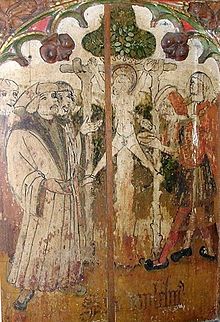| Thomas of Monmouth | |
|---|---|
| Born | twelfth century Monmouth, Wales |
| Died | after 1172 Norwich, England |
| Occupation(s) | monk, writer |
| Known for | The Life and Passion of William of Norwich |
Thomas of Monmouth (fl. 1149–1172) was a Benedictine monk who lived in the Priory at Norwich Cathedral, England during the mid-twelfth century. He was the author of The Life and Miracles of St William of Norwich, a hagiography of William of Norwich that is considered the earliest example of the ritual murder libel.
Career
Thomas of Monmouth’s only known work is the Vita et Passione Sancti Willelmi Martyris Norwicensis, as it is described in the only extant manuscript, Cambridge University Library MS. Add. 3037. It has been edited and translated by Augustus Jessop and M. R. James as The Life and Miracles of William of Norwich and by Miri Rubin as The Life and Passion of William of Norwich. In this book, Thomas of Monmouth falsely claims that a boy, William, who has been found dead in the forest, was in fact murdered by Jews in a re-enactment of the crucifixion, and that he therefore is a saint.
Life of William
Main article: William of Norwich
This is the earliest textual record of an accusation of ritual murder against the Jews. In a seminal article, Gavin Langmuir argued that Thomas of Monmouth himself had made the whole thing up. Subsequent historians have suggested instead that Thomas heard and elaborated on rumors that were already circulating or that the accusation was created as a fake cover story for the murder by a knight called Simon of Novers of a Jew called Eleazar, to whom Simon was in debt. Whatever the case, Thomas’s book has had a lasting and pernicious impact.
The single surviving manuscript of Thomas' work was discovered by M. R. James and published in 1896 with historical essays by James and Augustus Jessopp.
Works
- Thomas of Monmouth. (1896), Jessopp, Augustus; James, M. R. (eds.), The Life and Miracles of St William of Norwich (in Latin and English) (1896 ed.), Cambridge: Cambridge University Press (published 1172), OL 7250037M
- Thomas of Monmouth, The Life and Passion of William of Norwich. Trans. Miri Rubin (London: Penguin Classics, 2014)
References
- Rubin, Miri (2014). The Life and Passion of William of Norwich. London: Penguin Classics.
- Langmuir, Gavin (1984). ""Thomas of Monmouth: Detector of Ritual Murder"". Speculum. 59 (3): 820–846. doi:10.2307/2846698. JSTOR 2846698. S2CID 162522804.
- McCulloh, John (1997). ""Jewish Ritual Murder: William of Norwich, Thomas of Monmouth, and the Early Dissemination of the Myth"". Speculum. 72 (3): 698–740. doi:10.2307/3040759. JSTOR 3040759. S2CID 162659843.
- Rose, E. M. (2015). The Murder of William of Norwich: the Origins of the Blood Libel in Medieval Europe. Oxford: Oxford University Press.
Rose's conclusions have been challenged by Eamon Duffy, Royal Books and Holy Bones: Essays in Medieval Christianity. London: Bloomsbury Publishing, 2018.